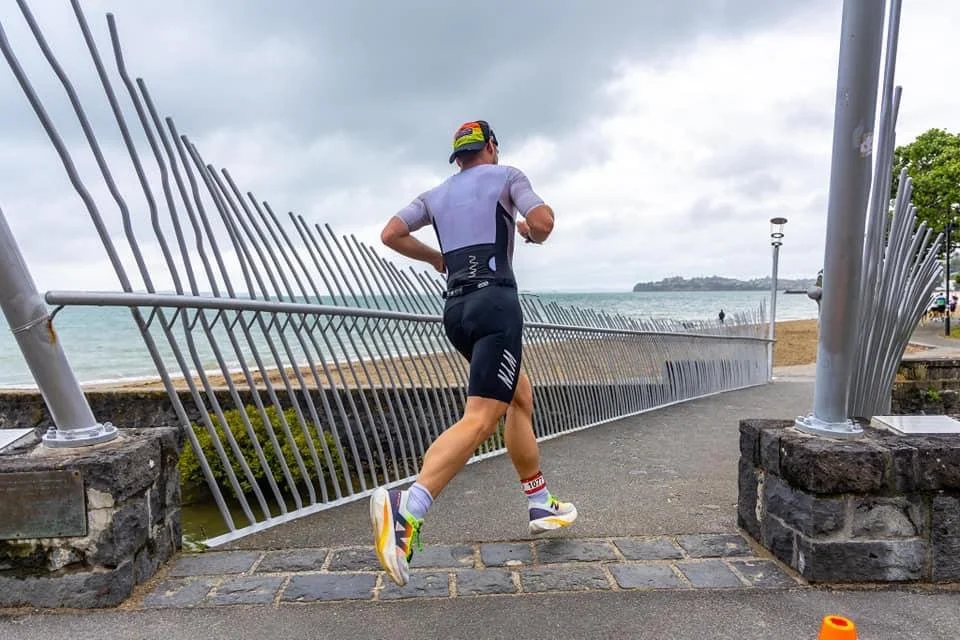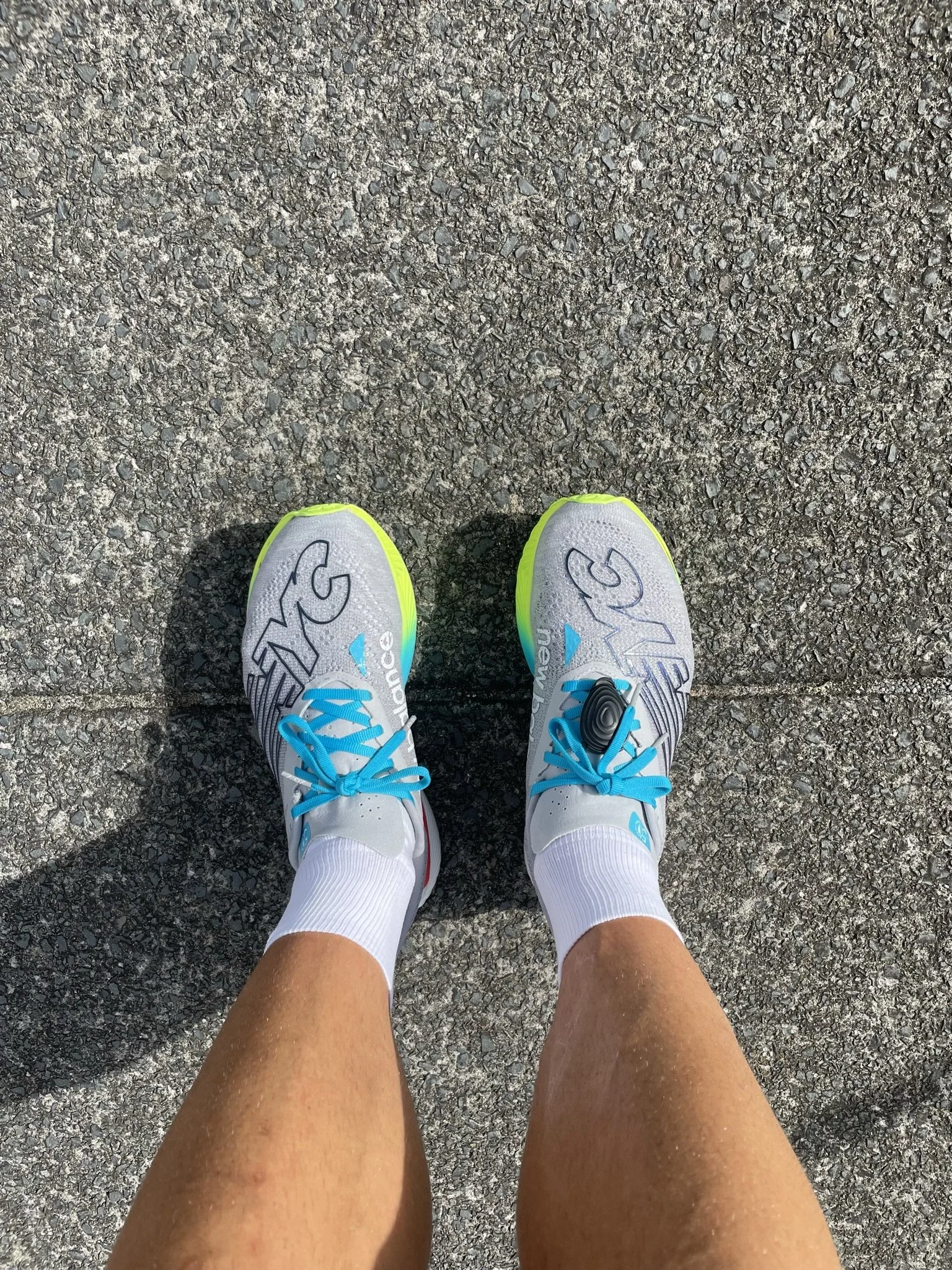Running Shoes Explained
How to choose the right pair for racing and training
When it comes to triathlon, running shoes might seem like a small piece of the puzzle—but they play a huge role in keeping you comfortable, injury-free, and fast. Whether you're training for your first sprint or eyeing up an Ironman, choosing the right pair of running shoes can make all the difference.
In this article, we’ll break down the key features of running shoes, the types available, and what to consider when picking the perfect pair for your goals.
Before you buy anything, read this.
Everybody’s feet are different. There will be shoes that are not for you, as much as that sucks, you must accept that. You might see a pair that look awesome but never buy shoes based on looks alone. Do not buy any shoes until you’ve been to get fitted properly at a specialist sports shoe store.
Yes those Nike Alphaflys have a carbon plate, but they won’t make you fast if you’re running 6:00 min/km. Yes those On Cloud Boom Echos are beautiful, but if you have wide feet and they’re too tight, you’re going to be in pain.
Now that we’ve got this out the way, read on. Let’s start with the anatomy of a shoe.
The Anatomy of a Running Shoe
Upper: The fabric part that wraps around your foot. It should feel snug but not restrictive.
Midsole: This is where most of the cushioning lives. It's the layer between your foot and the ground.
Outsole: The bottom layer that grips the road or trail.
Heel-to-Toe Drop: The difference in cushioning height from the heel to the forefoot. A higher drop can encourage heel striking, while a lower drop supports a more natural gait.
Support Features: Some shoes offer stability for overpronation (when your foot rolls inward too much) or extra cushioning for long-distance comfort.
Types of Running Shoes
1. Neutral Shoes
Best for: Most runners with a neutral gait.
Features: Balanced cushioning and flexibility.
Examples: Nike Pegasus, Brooks Ghost, ASICS Cumulus.
2. Stability Shoes
Best for: Runners who overpronate (feet roll inwards).
Features: Firmer foam or support rails to guide your stride.
Examples: Brooks Adrenaline, ASICS GT-2000, Saucony Guide.
3. Max-Cushion Shoes
Best for: Long runs, recovery runs, or runners who love a soft ride.
Features: Thick midsoles and lots of shock absorption.
Examples: HOKA Clifton, New Balance More, ASICS Nimbus.
4. Lightweight/Tempo Shoes
Best for: Speed sessions, tempo runs, or races.
Features: Less cushioning, lighter materials, responsive feel.
Examples: Saucony Kinvara, Nike Zoom Tempo Next%, Adidas Adios.
5. Carbon Plate Super Shoes
Best for: Race day, chasing PBs.
Features: A carbon plate for propulsion, super foam for bounce.
Examples: Nike Alphafly, ASICS Metaspeed, Saucony Endorphin Pro.
Training vs. Racing Shoes
As a triathlete, you’ll want a solid daily trainer for most of your runs, think comfort, durability, and support.
But for race day? That’s when many athletes bring out the "super shoes." These carbon-plated rockets can make a noticeable difference in performance, especially in longer events.
It’s worth testing them in a few key sessions before race day to make sure your body adjusts to the different feel.
Some races like Ironman and 70.3 have rules around shoes. It’s best to check the official Ironman rules for a list of banned shoes before committing to purchasing a pair you plan to race in.
How to Choose the Right Pair
Here are a few tips for finding your perfect match:
Get Fitted: Visit a specialist running store that offers gait analysis. They'll assess how you run and recommend shoes that match your mechanics, foot size and width.
Don’t Buy for Looks: We get it some shoes just look fast. But comfort and fit always come first.
Rotate Your Shoes: Having a couple of pairs on rotation (e.g., one for easy runs, one for speed) can extend their lifespan and reduce your risk of injury.
Listen to Your Body: The right shoe should disappear on your feet. If you’re feeling aches or niggles, it might be time for a new pair or a different type.
Test Them Out: Some stores offer a money-back guarantee if the shoes don’t work out. Test them in the real world and take them back if they don’t fit. For those stores which don’t offer refunds on used stores, test them out on a treadmill, this will show minimal wear on the sole and you should be able to return them.
How Many Pairs Do I Need?
If you only want one pair of shoes that’s fine. Running shoes aren’t cheap, so it’s fine to start with one pair and consider purchasing another as you progress through your triathlon training. In an ideal running shoe rotation, 3 pairs are enough:
1. Daily Trainer (1 pair)
Use for: Most of your weekly volume, easy runs, long runs, aerobic sessions.
Traits: Durable, cushioned, comfortable.
Examples: Brooks Ghost, ASICS Novablast, Saucony Ride.
2. Speed/Tempo Shoe (1 pair)
Use for: Intervals, tempo runs, and threshold workouts.
Traits: Lightweight, responsive, slightly less cushioned.
Examples: Nike Zoom Fly, Saucony Endorphin Speed, Hoka Mach.
3. Race Day Shoe (1 pair)
Use for: Races and key race-pace brick sessions.
Traits: Carbon-plated (often), very lightweight, high energy return.
Examples: Nike Alphafly/Next%, ASICS Metaspeed Sky, Saucony Endorphin Pro.
You can definitely get by with 2 (trainer + racer), but if you're training seriously (or chasing PBs), 3 is worth it.
Why Rotate?
Reduces injury risk (different shoes = different stress distribution).
Extends shoe lifespan (each pair gets more recovery time).
Trains different muscle groups slightly differently.
Allows you to match the shoe to the training purpose.
When Do I Need A New Pair?
You should generally replace your running shoes every 500–800 km (300–500 miles), but the right time for you depends on several factors:
Worn-out tread – Check the sole. If the grip is smooth or uneven, it’s time.
Loss of cushioning – If they feel flat, hard, or you notice more joint/muscle soreness post-run.
Uneven wear – Look at the heel or forefoot wear pattern. Misalignment = worn midsole.
Nagging injuries – New aches in your knees, shins, or feet can be a clue.
Creased midsole – Deep wrinkles in the foam indicate it's compressed and done.
Other Considerations:
Heavier runners: May need to replace shoes sooner.
Running style (heel striker vs. forefoot): Affects which part wears fastest.
Shoe type: Lightweight racing flats and minimalist shoes often wear out faster.
Rotation: If you rotate pairs, each will last longer.
Top Tip: Use apps like Strava or Garmin to assign shoes to runs and they’ll log your distance and notify you when they’re due for retirement.
Final thoughts
Running shoes aren’t magic but the right pair can make your triathlon journey smoother, faster, and more enjoyable. With so many options on the market, it’s easy to get overwhelmed. But once you understand the basics and tune into what works for you, you’re well on your way.
Still not sure what to go for? As coaches, we’re happy to give personalised recommendations based on your training, gait, and goals. Drop us a message anytime!

